Pioneer Railways Build on New Technology
At the time of the American Revolution, most of the Country's towns were along the Atlantic coastline and rivers. Ships provided transportation of goods and people between the towns. During the years that followed the Revolution, the new country began looking Westward. The interior was already being cultivated. The concept of exchanging food from the interior regions with eastern manufactured goods had taken hold.
Rivers, Canals and Steamboats
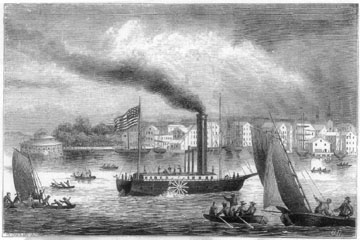 The
first practical steam engine propelled boat in North American waters was introduced in 1807
by Robert Fulton on the Hudson River at New York, it had a paddle wheel on both sides. Fulton's North
River Steamboat also known as the Clermont successfully
plied its way against the wind and current up the river to Albany, a 150 mile trip, in 32
hours. By 1810 a number of steamboats could be found on the Hudson and Delaware rivers, most
of them transporting goods between Philadelphia and New York.
The
first practical steam engine propelled boat in North American waters was introduced in 1807
by Robert Fulton on the Hudson River at New York, it had a paddle wheel on both sides. Fulton's North
River Steamboat also known as the Clermont successfully
plied its way against the wind and current up the river to Albany, a 150 mile trip, in 32
hours. By 1810 a number of steamboats could be found on the Hudson and Delaware rivers, most
of them transporting goods between Philadelphia and New York.
During the first decades of of the nineteenth century, the United States government favored time proven rivers, canals and roads over the new railway technology. The United States slowly began digging canals to connect the natural waterways. The roads were too poor and too slow to transport goods. Canals were the tried and true way to transport goods where there were no natural waterways for riverboats to navigate.
Early Nineteenth Century canal projects included:
- The Erie Canal, connecting the Hudson River and Lake Erie, was completed in 1825, helping establish New York as a leading center for trade. The Erie Canal was 363 miles long with 82 locks.
- The Blackstone Canal, linking Worcester, Massachusetts to Providence, Rhode Island (and Narragansett Bay) through the Blackstone Valley. Construction began in 1825. The 45 miles long canal opened in October 1828.
- The Delaware and Hudson Canal running from Kingston, New York on the Hudson River southwest to Port Jervis, New York on the Delaware River and beyond to the anthracite coal fields near Carbondale, Pennsylvania opened to navigation in October 1828.
Railroads and Steam Locomotives Emerge in England
The development of the railroads that we know today represents a convergence of two technologies. The concept of running heavy carriages on a "rail road" of parallel rails or tracks wasn't entirely new, it was in common use in Medieval mines and in other industries. The use of rails offered reduced friction and guided the carriages so they didn't need to be steered.
Horses provided the pulling power on these tramroads or railroads. Cast iron rails had been introduced in the 1770's, and a superior wrought iron "edge rail" had been introduced in the 1790's.
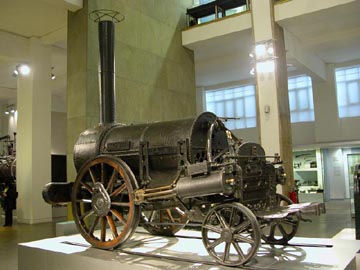 The second part of the equation involved propelling the carriages using steam locomotion. In
England, a new cutting-edge transportation technology was emerging. In 1804 Richard Trevithick
demonstrated that his new steam locomotive could pull a 10 ton train along parallel tracks on
the Pennydarren tramroad near Merthyr Tydfil in South Wales. In 1812 Matthew Murray built the The
Salamanca, the first or four successful twin cylinder locomotives built for the Middleton
Railway.
The second part of the equation involved propelling the carriages using steam locomotion. In
England, a new cutting-edge transportation technology was emerging. In 1804 Richard Trevithick
demonstrated that his new steam locomotive could pull a 10 ton train along parallel tracks on
the Pennydarren tramroad near Merthyr Tydfil in South Wales. In 1812 Matthew Murray built the The
Salamanca, the first or four successful twin cylinder locomotives built for the Middleton
Railway.
George Stephenson introduced his first steam locomotive, the Blucher, while working at the Killingworth Colliery in 1814. In 1821 George Stephenson convinced a group of promoters looking to build a public tramway between Stockton and Darlington that a steam locomotive could successfully transport general traffic. He was soon appointed chief engineer for the Stockton and Darlington Railroad, which opened in September 1825, the first common carrier public railroad. George Stephenson established the gauge, or distance between the rails as 4 ft. 8 1/2 inches, following the gauge of the colliery railroads.
During the years that followed, a slow procession of new inventions began to give shape to this new technology. Stephenson, working with his son Robert, constructed the Liverpool and Manchester Railway between the Port of Liverpool, and east Lancashire. When the Liverpool and Manchester Railway was approaching completion, the directors of the railway ran a competition to decide whether stationary steam engines and cable or locomotives would be used to pull the trains. The Rainhill Trials were held as an open contest that would let them see all the locomotive candidates in action in October 1829, with the choice to follow. Robert Stephenson entered a more advanced locomotive he called the Rocket, which won the Rainhill Trials and convinced the world that railroads were the wave of the future.
Pioneer Railroad Development in the United States
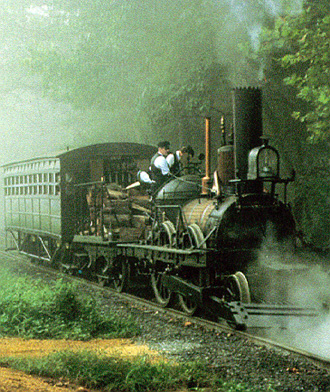 As
the new century dawned in the United States there were few short tramways in use. A primitive
cable tramway using grooved logs was reportedly in use hauling military supplies in 1764 in
Lewiston, New York. In 1795 a railway consisting of a short track of wooden rails was in service
in Boston with horses providing the "horse
power." In 1810 the Leiper Railroad was constructed to carry quarried stone 3/4 mile to
the tide-water near Philadelphia using "horse power." In 1826 another tramway, the Quincy Granite
Railroad was built to haul stone, it also used "horse
power."
As
the new century dawned in the United States there were few short tramways in use. A primitive
cable tramway using grooved logs was reportedly in use hauling military supplies in 1764 in
Lewiston, New York. In 1795 a railway consisting of a short track of wooden rails was in service
in Boston with horses providing the "horse
power." In 1810 the Leiper Railroad was constructed to carry quarried stone 3/4 mile to
the tide-water near Philadelphia using "horse power." In 1826 another tramway, the Quincy Granite
Railroad was built to haul stone, it also used "horse
power."
Money to develop the public railways in the United States needed to come primarily from the private sector. Tracing these early years of development becomes somewhat clouded, but here is a brief timeline:
- 1815 - Colonel John Stevens of Hoboken, New Jersey, gets a charter from the New Jersey legislature to build and operate a railroad between New Brunswick and Trenton. In 1823 he gets another charter from Pennsylvania to build from Philadelphia to the Susquehanna River, a few miles south of Harrisburg. Unfortunately, however, he cannot raise money to start construction on either line.
- 1825 - Colonel John Stevens designed and built a small single piston steam locomotive, then build a 630 foot oval track in his yard to run this model locomotive, making it the first locomotive to run in North America.
- 1826 - Philadelphians in the "Pennsylvania Society for the Promotion of Internal Improvements" sent one of their members, William Strictland to England to study the horse powered tramways. He returned from England and reported that the railroad was much to be preferred to the canals in the United States, his report was passed along to the Pennsylvania Canals Commission. The document was effective, ultimately resulting in the 400 miles long canal and railroad Main Line of Public Works system connecting Pittsburgh and Philadelphia.
- 1827 - The Baltimore & Ohio Railroad was chartered by the stare of Maryland to link Baltimore with the Ohio River. Construction began on July 4, 1828. The first 13 miles of the B&O line began service in 1830 with horses provided the first motive power. The horse pulled cars were the first in the United States to pull passengers. An experimental locomotive Tom Thumb was built by Peter Cooper for the line in August 1830 which successfully demonstrated that it could pull 36 passengers at speeds up to 18 miles per hour. Unfortunately Tom Thumb proved too small for regular service. In 1831 the B&O held a contest for the best steam locomotive which was won by Phineas Davis's entry, called the York. Davis was paid $4,000 for his locomotive and hired by the B&O.
- 1829 - The Delaware and Hudson Canal Company built a nine mile long railroad line from the Delaware and Hudson Canal at Honesdale, Pennsylvania to Moosic Mountains near Carbondale, to get the anthracite from the William Wurts' mine. Horatio Allen successfully ran the first full size locomotive the United States, the Stourbridge Lion, on August 8, along a section of track. The locomotive was English built.
- 1829 - Track laying was begun on the Philadelphia and Columbia Railroad in February 1829. The first twenty miles of track westward from Philadelphia opened in September 1832 with horses drawing the first cars. The line was completed to the Pennsylvania Canal at Columbia in October 1834, a total of 82 miles with steam locomotives pulling trains. Also connecting to the Pennsylvania Canal, the Allegheny Portage Railroad from Johnstown to Hollidaysburg. Also completed in 1834, the line was approximately 36 miles long. Both were financed by the State of Pennsylvania as part of the 400 miles long canal and railroad Main Line of Public Works system connecting Pittsburgh and Philadelphia.
- 1830 - Work began on the Charleston and Hamborg from Charleston, South Carolina to the Savannah River, a six mile long line. In December 1830 the locomotive named Best Friend pulled the first scheduled passenger train of several cars ever moved by steam on tracks in the United States. On opening day the train reportedly ran at a rate of 21 miles per hour. The locomotive was built by the West Point Foundry in New York. Unfortunately, the Best Friend's boiler exploded in June 1831 when the safety valve was held closed. The locomotive was replaced by the West Point which was already on hand.
- 1830 - Robert Livingston Stevens and Edwin A. Stevens, sons of Colonel
John Stevens obtained another charter from New Jersey under which the
Camden and Amboy Railroad was built, connecting with Philadelphia and
New York water transit. Robert Livingston Stevens designed the first "T" shaped
rail, the hook-headed spikes, and the "iron tongue" or fishplate used to join the
rails on the line, designs commonly used on railroads today. The locomotive John
Bull, designed by Robert Stevenson, was
imported from England, and began limited service in 1831. Regular service began with the lines
completion to Perth Amboy in 1832. Travel time between New York and Philadelphia was reduced
to seven hours (sea and rail time combined). The John Bull was officially retired in 1866,
but was preserved, today it resides at the Smithsonian Institute in Washington, DC.
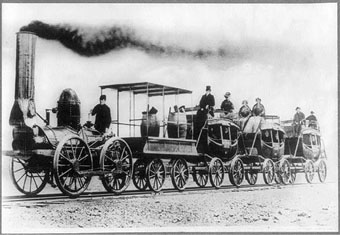

- 1831 - The West Point Foundry supplied the newly completed Mohawk and Hudson Railroad with the locomotive De Witt Clinton. The Albany Argus reported that "the engine performed the entire route in less than one hour, including stoppages, and on a part of the road its speed was at the rate of thirty miles an hour." This line connect the Mohawk River at Schenectady to the Hudson River at Albany, providing a way for cargo on steamboats to avoid the Erie Canal.
- 1831- Construction was completed on the Pontchartrain Railroad in April 1831, between the Mississippi River front of New Orleans and Lake Pontchartrain with horse drawn railway cars. The first steam locomotive, The Shields, arrived in June 1832, but proved unreliable; a second locomotive The Pontchartrain proved better, allowing the line to advertise regular steam service starting in September 1832.
- 1931 - The New Castle and Frenchtown Turnpike and Rail Road Company, opened a new railroad opened in 1831, replacing the turnpike from New Castle, Delaware on the Delaware Bay west-southwest to Old Frenchtown Wharf, Maryland on the Chesapeake Bay. The line used horses for about a year before switching to steam locomotives.
- 1832 - The Philadelphia, Germantown and Norristown railroad, from Ninth and Green streets in Philadelphia to Germantown, opened in June 1832. Initially the cars were drawn by horses, making the six mile trip in three-quarters of an hour. Cars left the depot at intervals of two hours. Fare twenty-five cents. In November 1832, a locomotive engine, built by Matthias W. Baldwin was introduced. The engine ran beyond the township line at a reported speed of about twenty-eight miles per hour, making the trip in 28 minutes.
- 1833 - Andrew Jackson travels from Baltimore to Ellicot's Mills, becoming the first President of the United States to ride a railroad while in office. A total of 380 miles of railroad track are in operation in the United States.
- 1834 - The Brooklyn and Jamaica Railroad opened a ten-mile track from the East River in Brooklyn to the Long Island town of Jamaica, New York. The line became part of the Long Island Railroad in 1836.
- 1835 - There are 1,098 miles of steam railroad tracks in use in eleven states.
- 1838 - Five of the Six New England states have rail service, as do the frontier states of Kentucky and Indiana.
- 1838 - The United States Congress officially designated all railroads as official postal routes in July 1838
- 1840 - There are more than 2,800 miles of track in operation in the United States
- 1842 - Charles Dickens, rode railroads while visiting the United States, compared US to English railroads writing that" there are no first and second class carriages as with us; but there is a gentleman's and a ladies' car; the main distinction between which is that in the first, everybody smokes; and the second, nobody does."
- 1850 - There were more that 9,000 miles of railroad lines in service, as much as in the rest of the world combined.
- 1852 - The first train ran on the first railroad west of the Mississippi River, the Pacific Railroad of Missouri in December 1852, from St. Louis to Cheltenham, a distance of five miles.
By 1860 more that 30,000 miles of track are in operation in the United States, including California. Railroads enabled access to new parts of the growing nation and provided the the means for towns and cities to develop in these areas. The railroads provided ways to transport the mineral, timber and agricultural products to market, and helped bind the developing parts of our nation together.
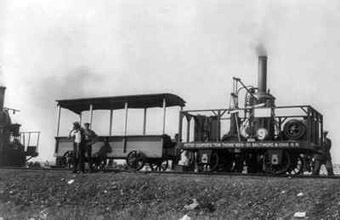
| Region | 1850 | 1860 | 1870 | 1880 | 1890 |
|---|---|---|---|---|---|
| New England | 2,507 | 3,660 | 4,494 | 5,982 | 6,831 |
| Middle States | 3,202 | 6,705 | 10,964 | 15,872 | 21,536 |
| Southern States | 2,036 | 8,838 | 11,192 | 14,778 | 29,209 |
| Western States and Territories | 1,276 | 11,400 | 24,587 | 52,589 | 62,394 |
| Pacific States and Territories | 0 | 23 | 1,677 | 4,080 | 9,804 |
| Totals | 9,021 | 30,626 | 52,914 | 93,301 | 129,774 |
Sharing A Heritage Railroad History Train Technology Railroad Operation Railroad Time Museums & Heritage Railroads Railroads Today
